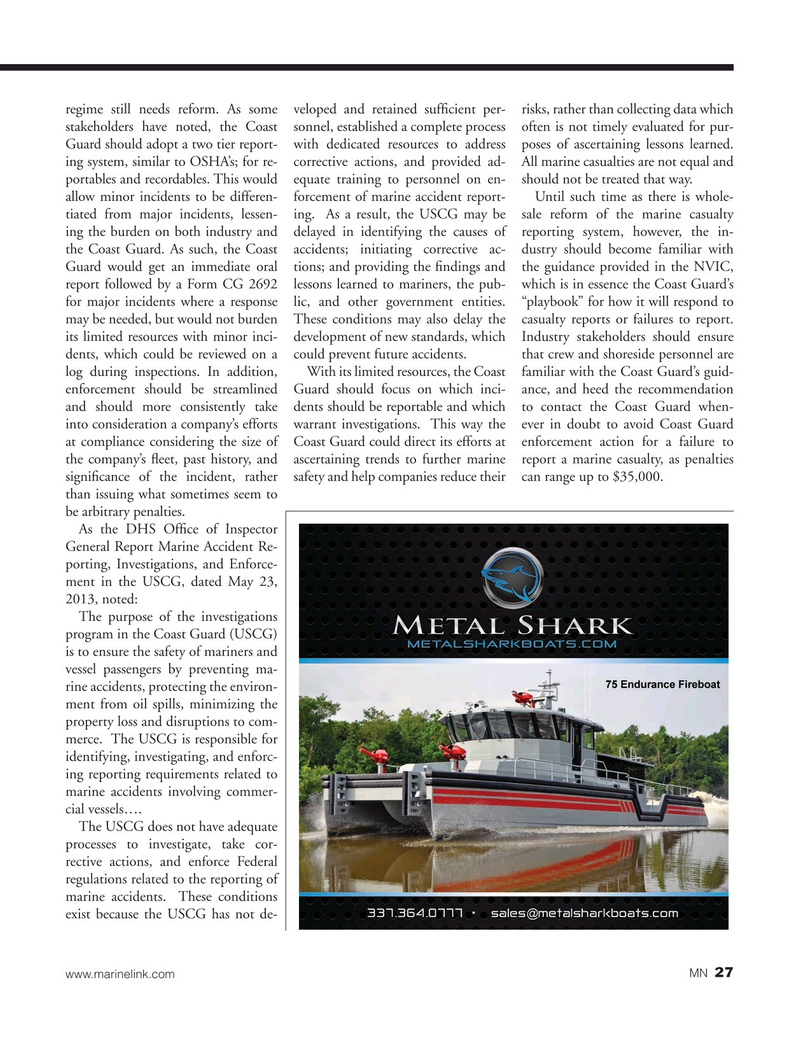
Page 27: of Marine News Magazine (October 2015)
Salvage & Spill Response
Read this page in Pdf, Flash or Html5 edition of October 2015 Marine News Magazine
regime still needs reform. As some veloped and retained suf? cient per- risks, rather than collecting data which stakeholders have noted, the Coast sonnel, established a complete process often is not timely evaluated for pur-
Guard should adopt a two tier report- with dedicated resources to address poses of ascertaining lessons learned. ing system, similar to OSHA’s; for re- corrective actions, and provided ad- All marine casualties are not equal and portables and recordables. This would equate training to personnel on en- should not be treated that way.
allow minor incidents to be differen- forcement of marine accident report- Until such time as there is whole- tiated from major incidents, lessen- ing. As a result, the USCG may be sale reform of the marine casualty ing the burden on both industry and delayed in identifying the causes of reporting system, however, the in- the Coast Guard. As such, the Coast accidents; initiating corrective ac- dustry should become familiar with
Guard would get an immediate oral tions; and providing the ? ndings and the guidance provided in the NVIC, report followed by a Form CG 2692 lessons learned to mariners, the pub- which is in essence the Coast Guard’s for major incidents where a response lic, and other government entities. “playbook” for how it will respond to may be needed, but would not burden These conditions may also delay the casualty reports or failures to report. its limited resources with minor inci- development of new standards, which Industry stakeholders should ensure dents, which could be reviewed on a could prevent future accidents. that crew and shoreside personnel are log during inspections. In addition, With its limited resources, the Coast familiar with the Coast Guard’s guid- enforcement should be streamlined Guard should focus on which inci- ance, and heed the recommendation and should more consistently take dents should be reportable and which to contact the Coast Guard when- into consideration a company’s efforts warrant investigations. This way the ever in doubt to avoid Coast Guard at compliance considering the size of Coast Guard could direct its efforts at enforcement action for a failure to the company’s ? eet, past history, and ascertaining trends to further marine report a marine casualty, as penalties signi? cance of the incident, rather safety and help companies reduce their can range up to $35,000.
than issuing what sometimes seem to be arbitrary penalties.
As the DHS Of? ce of Inspector
General Report Marine Accident Re- porting, Investigations, and Enforce- ment in the USCG, dated May 23, 2013, noted:
The purpose of the investigations program in the Coast Guard (USCG) is to ensure the safety of mariners and vessel passengers by preventing ma- rine accidents, protecting the environ- ment from oil spills, minimizing the property loss and disruptions to com- merce. The USCG is responsible for identifying, investigating, and enforc- ing reporting requirements related to marine accidents involving commer- cial vessels….
The USCG does not have adequate processes to investigate, take cor- rective actions, and enforce Federal regulations related to the reporting of marine accidents. These conditions exist because the USCG has not de- 27 www.marinelink.com MN
MN Oct15 Layout 18-31.indd 27 9/21/2015 11:10:20 AM

 26
26

 28
28
